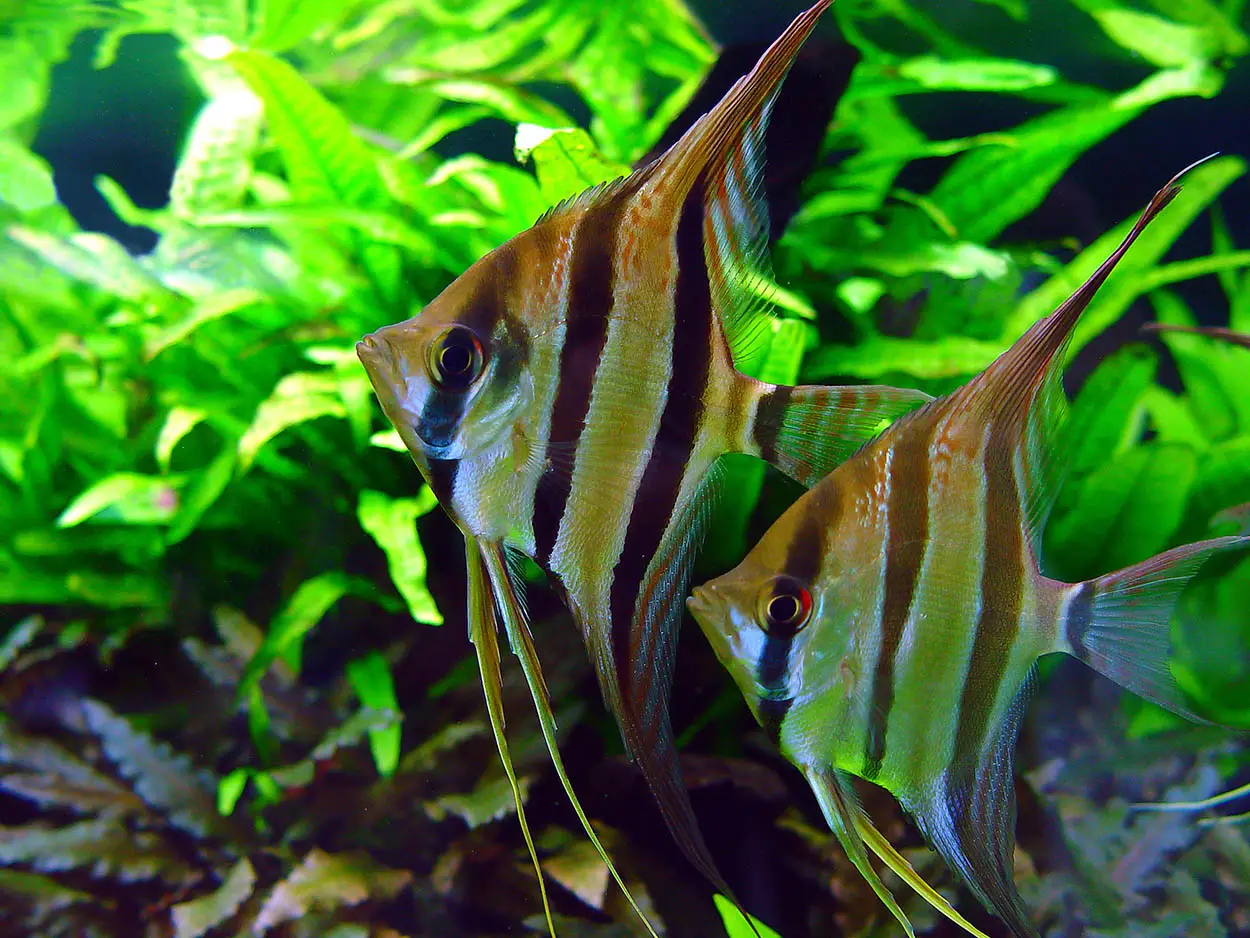Angelfish

The Angelfish, with its elegant fins and majestic swimming, is a true jewel of the freshwater aquarium. Originally hailing from the Amazon basin, these cichlids have captured the hearts of aquarists worldwide. While their beauty is undeniable, successful Angelfish keeping requires a deep understanding of their specific needs. This extended article will delve into every aspect of Angelfish care, from ideal tank setups to detailed water parameters, ensuring your aquatic angels thrive.
A Closer Look at the Angelfish (Pterophyllum scalare)
There are three main species of Angelfish commonly found in the aquarium trade: Pterophyllum scalare (the most common), Pterophyllum altum (the much larger and more challenging Altum Angelfish), and Pterophyllum leopoldi (a smaller, less common species). This article will primarily focus on Pterophyllum scalare, the variety most readily available and suitable for a wider range of aquarists.
Angelfish are renowned for their disc-shaped bodies, elongated dorsal and anal fins, and graceful movements. They come in a breathtaking array of colours and fin variations, including Marble, Koi, Black, Platinum, Zebra, and many more. They are intelligent and can even recognise their owners, making them a truly rewarding pet.
Tank Requirements: Size Matters!
One of the most critical aspects of Angelfish care is providing adequate tank space. Their tall fins and potential adult size demand a spacious environment. While a single Angelfish might survive in a smaller tank, to truly thrive and exhibit their natural behaviours, more room is essential.
- Minimum Tank Size: For a single adult Angelfish, a minimum of 60 litres (approximately 15 gallons) is often cited, but this is truly the bare minimum.
- Recommended Tank Size for a Pair: A pair of adult Angelfish will require at least 120 litres (approximately 30 gallons).
- For a Group/Community Tank: If you plan on keeping a small group (3-5 Angelfish) or want them to be part of a community tank, aim for 200 litres (approximately 50 gallons) or larger. Remember, the taller the tank, the better, to accommodate their fin height.
Aquascaping for Angelfish: Creating a Natural Habitat
Recreating elements of their natural Amazonian habitat will make your Angelfish feel more secure and display their best colours. Consider the following when aquascaping:
- Tall Plants: Angelfish appreciate tall, broad-leaved plants like Amazon Swords, Cryptocorynes, and Java Ferns. These provide hiding spots, reduce stress, and can even be used for spawning.
- Driftwood and Rocks: Strategically placed driftwood branches and smooth rocks offer additional hiding places and contribute to a natural aesthetic. Ensure any rocks are inert and won’t alter water chemistry.
- Open Swimming Space: While they appreciate cover, Angelfish also need ample open swimming space, especially in the middle and upper levels of the tank.
- Substrate: A fine-grained substrate like sand or smooth gravel is ideal. Avoid sharp or abrasive substrates that could injure their delicate fins.
Water Parameters: The Key to Health and Longevity
Maintaining stable and appropriate water parameters is paramount for Angelfish health. Regular testing is essential, and consistent water changes are vital. Here’s a detailed breakdown:
| Parameter | Ideal Range | Notes |
| Temperature | 24-28°C (75-82°F) | Stable temperature is crucial. Fluctuations can stress fish. |
| pH | 6.0-7.5 | Slightly acidic to neutral is preferred. Avoid sudden pH swings. |
| GH (General Hardness) | 2-10 dGH (35.7-178.6 ppm) | Soft to moderately hard water. |
| KH (Carbonate Hardness) | 3-8 dKH (53.6-143.2 ppm) | Provides buffering capacity against pH swings. |
| Ammonia (NH₃) | 0 ppm | Highly toxic. Any detectable level is dangerous. |
| Nitrite (NO₂) | 0 ppm | Highly toxic. Any detectable level is dangerous. |
| Nitrate (NO₃) | <20 ppm | While less toxic than ammonia/nitrite, high levels indicate poor water quality. Aim for as low as possible. |
Water Changes: Weekly water changes of 20-30% are recommended to keep nitrates low and replenish essential minerals. Always use a good quality water conditioner to neutralise chlorine and chloramines from tap water.
Filtration: Crystal Clear and Healthy Water
A robust filtration system is essential for maintaining optimal water quality. Consider the following types:
- Hang-on-Back (HOB) Filters: Suitable for smaller tanks, providing mechanical and biological filtration.
- Canister Filters: Excellent for larger tanks, offering superior mechanical, biological, and chemical filtration. They also allow for greater media customisation.
- Sponge Filters: Good for breeding tanks or as supplemental filtration, providing gentle biological filtration.
Ensure your filter provides adequate flow without creating too much current, as Angelfish prefer calmer waters.
Diet and Feeding: A Balanced Approach

Angelfish are omnivores and require a varied diet to thrive. Offer a mix of high-quality foods to ensure all their nutritional needs are met.
- High-Quality Flakes or Pellets: Form the staple of their diet. Look for brands specifically formulated for cichlids or general tropical fish with a good protein content.
- Frozen Foods: Bloodworms, brine shrimp, daphnia, and Mysis shrimp are excellent sources of protein and provide enrichment. Thaw thoroughly before feeding.
- Live Foods (with caution): While live foods like small feeder fish or cultured worms can be offered, be mindful of potential disease transmission. It’s generally safer to stick to frozen options.
- Vegetable Matter: Occasional offerings of blanched spinach, spirulina flakes, or algae wafers can supplement their diet.
Feed small amounts 2-3 times a day, only what they can consume within a few minutes. Overfeeding leads to water quality issues.
Social Behaviour and Tank Mates
Angelfish are generally peaceful but can be territorial, especially during breeding. They are best kept in groups of 3-5 to spread out aggression or as a pair. Solitary Angelfish can become stressed.
Choosing appropriate tank mates is crucial:
- Good Tank Mates:
- Larger Tetras (e.g., Congo Tetras, Serpae Tetras – avoid very small Tetras like Neon Tetras as they may become food for adult Angels)
- Corydoras Catfish
- Plecos (e.g., Bristlenose Plecos)
- Rainbowfish
- Dwarf Cichlids (e.g., German Blue Rams)
- Gouramis (avoid very nippy varieties)
- Bad Tank Mates (to avoid):
- Nippy fin fish (e.g., Tiger Barbs, some Danio species)
- Very small fish (e.g., Neon Tetras, Guppies – as mentioned, they can be eaten)
- Aggressive Cichlids (e.g., Oscars, Jack Dempseys)
- Large, boisterous fish
Common Health Issues and Prevention
Like all fish, Angelfish can be susceptible to various diseases. Prevention is always better than cure:
- Ich (White Spot Disease): Appears as small white spots on the body and fins. Often caused by stress or rapid temperature changes. Treat with medication and raise temperature slowly.
- Fin Rot: Frayed or decaying fins, often due to poor water quality or injury. Improve water quality and use antibacterial medication.
- Hole in the Head Disease: Pitting and lesions on the head and lateral line. Often linked to poor water quality, nutritional deficiencies, or internal parasites.
- Bloat: Swollen abdomen, often caused by overfeeding or poor diet.
Prevention Strategies:
- Maintain excellent water quality through regular testing and water changes.
- Provide a balanced and varied diet.
- Quarantine new fish before introducing them to your main tank.
- Avoid overcrowding and sudden environmental changes.

Breeding Angelfish
Angelfish are relatively easy to breed in the home aquarium once a compatible pair has formed. They are egg layers and exhibit parental care.
- Pairing: Angelfish will often pair off naturally from a group. Once a pair forms, they may become territorial.
- Spawning Site: They prefer to lay eggs on vertical surfaces like broad plant leaves, slate, or even the aquarium glass.
- Egg Laying: The female will lay rows of eggs, and the male will follow, fertilising them.
- Parental Care: Both parents will guard and fan the eggs to keep them aerated and free of fungus.
- Hatching: Eggs typically hatch within 2-3 days, and the fry become free-swimming a few days later.
- Fry Food: Newly hatched brine shrimp are the ideal first food for Angelfish fry.
Conclusion: A Rewarding Aquatic Journey
Keeping Angelfish is a truly rewarding experience. Their beauty, grace, and unique personalities make them a captivating addition to any suitable aquarium. By understanding and diligently addressing their specific care needs – from providing ample space and stable water parameters to a varied diet and compatible tank mates – you can ensure your Angelfish not only survive but truly thrive, bringing years of enjoyment to your home.
Do you have any Angelfish already, or are you considering adding them to your aquarium?


